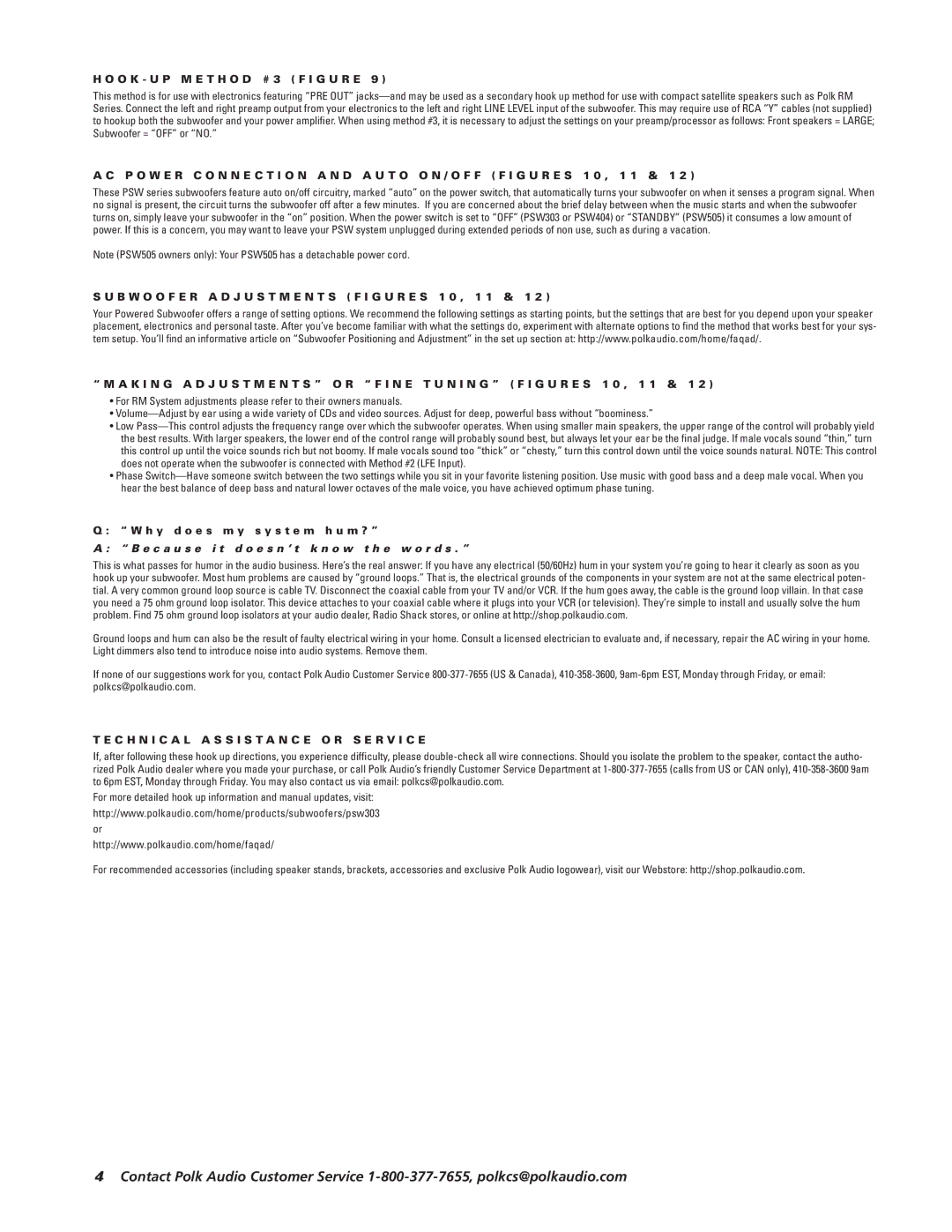H O O K - U P M E T H O D # 3 ( F I G U R E 9 )
This method is for use with electronics featuring “PRE OUT”
A C P O W E R C O N N E C T I O N A N D A U T O O N / O F F ( F I G U R E S 1 0 , 1 1 & 1 2 )
These PSW series subwoofers feature auto on/off circuitry, marked “auto” on the power switch, that automatically turns your subwoofer on when it senses a program signal. When no signal is present, the circuit turns the subwoofer off after a few minutes. If you are concerned about the brief delay between when the music starts and when the subwoofer turns on, simply leave your subwoofer in the “on” position. When the power switch is set to “OFF” (PSW303 or PSW404) or “STANDBY” (PSW505) it consumes a low amount of power. If this is a concern, you may want to leave your PSW system unplugged during extended periods of non use, such as during a vacation.
Note (PSW505 owners only): Your PSW505 has a detachable power cord.
S U B W O O F E R A D J U S T M E N T S ( F I G U R E S 1 0 , 1 1 & 1 2 )
Your Powered Subwoofer offers a range of setting options. We recommend the following settings as starting points, but the settings that are best for you depend upon your speaker placement, electronics and personal taste. After you’ve become familiar with what the settings do, experiment with alternate options to find the method that works best for your sys- tem setup. You’ll find an informative article on “Subwoofer Positioning and Adjustment” in the set up section at: http://www.polkaudio.com/home/faqad/.
“ M A K I N G A D J U S T M E N T S ” O R “ F I N E T U N I N G ” ( F I G U R E S 1 0 , 1 1 & 1 2 )
•For RM System adjustments please refer to their owners manuals.
•
•Low
•Phase
Q : “ W h y d o e s m y s y s t e m h u m ? ”
A : “ B e c a u s e i t d o e s n ’ t k n o w t h e w o r d s . ”
This is what passes for humor in the audio business. Here’s the real answer: If you have any electrical (50/60Hz) hum in your system you’re going to hear it clearly as soon as you hook up your subwoofer. Most hum problems are caused by “ground loops.” That is, the electrical grounds of the components in your system are not at the same electrical poten- tial. A very common ground loop source is cable TV. Disconnect the coaxial cable from your TV and/or VCR. If the hum goes away, the cable is the ground loop villain. In that case you need a 75 ohm ground loop isolator. This device attaches to your coaxial cable where it plugs into your VCR (or television). They’re simple to install and usually solve the hum problem. Find 75 ohm ground loop isolators at your audio dealer, Radio Shack stores, or online at http://shop.polkaudio.com.
Ground loops and hum can also be the result of faulty electrical wiring in your home. Consult a licensed electrician to evaluate and, if necessary, repair the AC wiring in your home. Light dimmers also tend to introduce noise into audio systems. Remove them.
If none of our suggestions work for you, contact Polk Audio Customer Service
T E C H N I C A L A S S I S T A N C E O R S E R V I C E
If, after following these hook up directions, you experience difficulty, please
For more detailed hook up information and manual updates, visit:
http://www.polkaudio.com/home/products/subwoofers/psw303
or
http://www.polkaudio.com/home/faqad/
For recommended accessories (including speaker stands, brackets, accessories and exclusive Polk Audio logowear), visit our Webstore: http://shop.polkaudio.com.
Contact Polk Audio Customer Service
